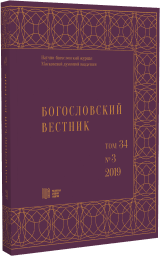Urim and Thummim in Ancient Israel: Critical Anal- ysis of Sources and Hypotheses
DOI:
https://doi.org/10.31802/2500-1450-2019-34-17-38Keywords:
Bible, old Testament, Book of kings, the will of God, Ancient Israel, Qumran exegesis the sacred text, Saul, David, the priest, the ephod, stones of the breastplate, the Urim and Thummim, the Oracle, the prophecy, fate, the revelationAbstract
The article analyzes the main scientific hypotheses about what Urim and Thummim were, what was their purpose and method of use. For this purpose, various sources are involved, starting with the oldest references in the manuscripts of Qumran, according to which Urim and Thummim were associated with precious stones on the shoulder pads or breastplate of the high priest’s ephod. This view in one way or another adhered to the majority of subsequent ancient writers (Josephus, the authors of the relevant episodes of the Babylonian Talmud, st. John Chrysostom, Theodore Kirsky, etc.). However, according to some Western commentators, Urim and Thummim are the names of the signs or letters on the breastplate (st. Augustine and St. Bede the Venerable). According to the third view, Urim and Thummim was an inscription with the name Yahweh or two inscriptions with Divine names inside the breastplate (Rashi, Ramban, etc.). The beginning of the twentieth century, the Urim and Thummim began to be regarded as a lot similar to Mesopotamian practices, based on the episode in 1 Sam. 14, 41–42 according to the Septu- agint. The author argues with this idea, arguing that, firstly, the original reading of this passage is preserved in a shorter version of the Hebrew text, and secondly, that the Urim and Thummim can not be a lot, and thirdly, that in the process of receiving an answer through the Urim and Thummim played a major role prophetic inspiration sent down by the Lord to the priest. The very expression «Urim and Thummim» could convey the idea of «perfect light» and, presumably, denote a precious stone, by which confirmed the truth of the words of the priest.
Downloads
References
Источники и переводы
Josephus. Jewish Antiquities, I-IV / trans. by H. St. J. Thackeray. Cambridge (Mass.): Harvard University Press; London: William Heinemann, 1961 (r1930).
Augustinus. Quaestiones Exodi // Aurelii Augustini Opera. Pars V: Quaestionum in Heptateuchum libri VII / ed. J. Fraipont. Turnholti: Brepols, 1958. P. 70–174. (CCSL; vol. 33).
Beda Venerabilis. De Tabernaculo // Bedae Venerabilis Opera. Pars II: Opera Exegetica. 2 A / ed. D. Hurst. Turnholti: Brepols, 1969. P. 5–139. (CCSL; vol. 119A).
Hieronymus Stridonensis. Commentaria in Ezechielem // PL. T. 25. Col. 15–490.
The Dead Sea Scrolls Study Edition / ed. by F. G. Martínez, E. J. C. Tigchelaar. 2 vols. Leiden; Boston; Köln: Brill, 1997–1998. Vol. 2.
The Works of Philo Judaeus. The Contemporary of Josephus / transl. from the Greek by C. D. Yonge. London: H. G. Bohn, 1854–1890. Reprint: The Works of Philo: Complete and Unabridged, New Updated Version / transl. by C. D. Yonge. Peabody (Mass.), 1993.
Библейские комментарии отцов Церкви и других авторов I-VIII веков. Ветхий Завет. Т. 3: Книги Исход, Левит, Числа, Второзаконие. Тверь: Герменевтика, 2010.
Гомер. Илиада / пер. В. В. Вересаева. М.: Гослитиздат, 1953.
Иероним Стридонский, блж. Четырнадцать книг толкований на пророка Иезекииля / Творения. Ч. 10. Киев: Киевская духовная академия, 1886.
Иоанн Златоуст, свт. Против иудеев: слово VI // Творения в 12 т. Т. 1. Кн. 2. СПб., 1898. С. 705–718.
Иосиф Флавий. Иудейские древности / пер. с греч. Г. Г. Генкеля. СПб., 1900. В 2 т. Переиздание: с пред. и прим. В. А. Федосика и Г. И. Довгяло. Минск: Беларусь, 1994.
Тацит. О происхождении германцев и местоположении Германии / пер. с лат. А. С. Бобовича, под ред. М. Е. Сергеенко // Корнелий Тацит. Сочинения в двух томах. Т. I: Анналы. Малые произведения. СПб.: Наука, 1993. С. 337–355.
Феодорит Кирский, блж. Изъяснение трудных мест Божественного Писания. М.: Издательский совет РПЦ, 2003.
Литература
Лихачёв Д. С. Текстология (на материале русской литературы X-XVII вв). СПб.: Алетейя, 2001.
Лопухин А. П. Книга Исход // Толковая Библия, или Комментарий на все книги Св. писания Ветхого и Нового Завета / под редакцией А. П. Лопухина. Т. 1. Пятикнижие Моисеево. СПб.: Типография П. Сойкина, 1904. С. 272–407.
Мень А., прот. Исагогика. М.: Фонд им. Александра Меня; Общедоступный Православный университет, осн. прот. Александром Менем, 2000.
Никифор (Бажанов), архим. Библейская энциклопедия. М.: «Локид Пресс», 2005.
Тантлевский И. Р. Царь Давид и его эпоха в Библии и истории. СПб.: Издательство РХГА, 2016.
Уолтон Дж. X., Мэтьюз В. X., Чавалес М. У. Библейский культурно-исторический ком- ментарий. Часть 1: Ветхий Завет. СПб.: Мирт, 2003.
Урим и туммим // Краткая еврейская энциклопедия. Иерусалим: Кетер, 1996. Т. 8. Кол. 1296.
Alter R. The David Story: A Translation with Commentary of 1 and 2 Samuel. New York: W. W. Norton & Company, 1999.
Bakon Sh. The Mystery of the Urim Ve-Tummim // Jewish Bible Quarterly. 2015. Vol. 43. Р. 241–254.
Brown F., Driver S. R, Briggs Ch. A. A Hebrew and English Lexicon of the Old Testament. Boston, New York: Clarendon Press, 1907.
Cross F. M. The Oldest Manuscripts from Qumran // Journal of Biblical Literature. 1955. Vol. 74. P. 147–172.
De Vaux R. Ancient Israel: Its Life and Institutions / trans. by J. McHugh. Grand Rapids (Mich.): Eerdmans; Livonia (Mich.): Dove, 1997.
Edelman D. V. From Prophets to Prophetic Books: The Fixing of the Divine Word // The Production of Prophecy: Constructing Prophecy and Prophets in Yehud / ed. by D. V., Ehud Ben Zvi. London: Equinox, 2009. P. 29–54.
Hertzberg H. W. I and II Samuel: A Commentary. Philadelphia: Westminster Press, 1964.
Holladay W. A Concise Hebrew and Aramaic Lexicon of the Old Testament. Grand Rapids (Mich.): Eerdmans Publishing Company, 1971.
Horowitz W., Hurowitz V (A). Urim and Thummim in Light of a Psephomancy Ritual from Assur (LKA 137) // Journal of the Ancient Near Eastern Society. 1992. Vol. 21. Р. 95–115.
Jirku A. Mantik in Altisrael. Inaugural Dissertation. Rostock: Erben, 1913.
Liesen J. A Common Background of Ben Sira and the Psalter: The Concept of הרות in Sir 32:14–33:3 and the Torah Psalms // The Wisdom of Ben Sira: Studies on Tradition, Redaction, and Theology / ed. by A. Passaro, G. Bellia. Berlin; New York: W. de Gruyter, 2008. P. 197–207.
Lindblom J. Lot-Casting in the Old Testament // Vetus Testamentum. 1962. Vol. 12. P. 164–178.
McCarter P. K. I Samuel. Garden City (New York): Doubleday, 1980.
Reiner E. Fortune-Telling in Mesopotamia // Journal of the Ancient Near Eastern Studies. 1960. Vol. 19. Р. 23–35.
Toeg A. A Textual Note on 1 Samuel XIV 41 // Vetus Testamentum. 1969. Vol. 19. P. 493–498.
Tsumura D. T. The First book of Samuel. Grand Rapids (Michigan): Eerdmans Publishing, 2007.
Van Dam C. The Urim and Thummim: A Means of Revelation in Ancient Israel. Winona Lake (Indiana): Eisenbrauns, 1997.
Wellhausen J. Der Text der Bücher Samuelis. Gottingen: Vandenhoeck und Ruprecht, 1871.








